Page 304 of 561
303 Controls in detail
Useful features
Ashtray in the front center console
Opening the ashtray
1Cover
2Chrome label�
Tab lightly on chrome label 2 of
cover1.
Cover 1 swings open.Removing ashtray insert
1Cover plate
2Ashtray insert
�
Grip ashtray insert 2 on the sides and
pull it out upwards.
Reinstalling ashtray insert
�
Insert ashtray insert 2 and push down
until the ball catch engages.
�
Close ashtray cover plate 1.
Warning!
G
Remove ashtray only with vehicle standing
still. Set the parking brake to secure vehicle
from movement. Set automatic transmis-
sion toP. With the automatic transmission
set toP, turn off the engine.
Page 333 of 561
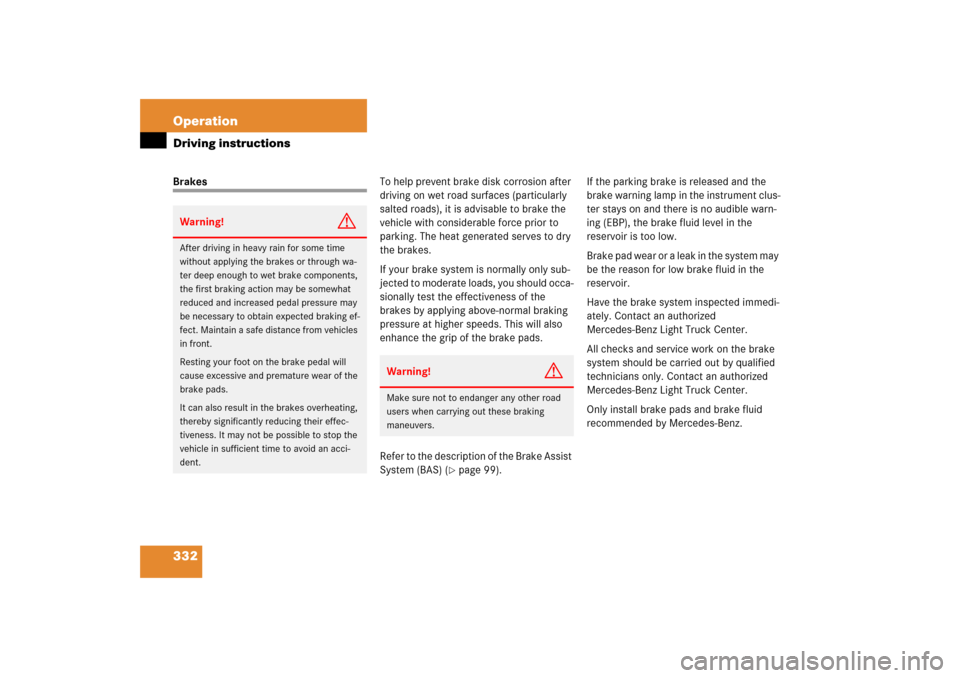
332 OperationDriving instructionsBrakesTo help prevent brake disk corrosion after
driving on wet road surfaces (particularly
salted roads), it is advisable to brake the
vehicle with considerable force prior to
parking. The heat generated serves to dry
the brakes.
If your brake system is normally only sub-
jected to moderate loads, you should occa-
sionally test the effectiveness of the
brakes by applying above-normal braking
pressure at higher speeds. This will also
enhance the grip of the brake pads.
Refer to the description of the Brake Assist
System (BAS) (
�page 99).If the parking brake is released and the
brake warning lamp in the instrument clus-
ter stays on and there is no audible warn-
ing (EBP), the brake fluid level in the
reservoir is too low.
Brake pad wear or a leak in the system may
be the reason for low brake fluid in the
reservoir.
Have the brake system inspected immedi-
ately. Contact an authorized
Mercedes-Benz Light Truck Center.
All checks and service work on the brake
system should be carried out by qualified
technicians only. Contact an authorized
Mercedes-Benz Light Truck Center.
Only install brake pads and brake fluid
recommended by Mercedes-Benz.
Warning!
G
After driving in heavy rain for some time
without applying the brakes or through wa-
ter deep enough to wet brake components,
the first braking action may be somewhat
reduced and increased pedal pressure may
be necessary to obtain expected braking ef-
fect. Maintain a safe distance from vehicles
in front.
Resting your foot on the brake pedal will
cause excessive and premature wear of the
brake pads.
It can also result in the brakes overheating,
thereby significantly reducing their effec-
tiveness. It may not be possible to stop the
vehicle in sufficient time to avoid an acci-
dent.
Warning!
G
Make sure not to endanger any other road
users when carrying out these braking
maneuvers.
Page 335 of 561
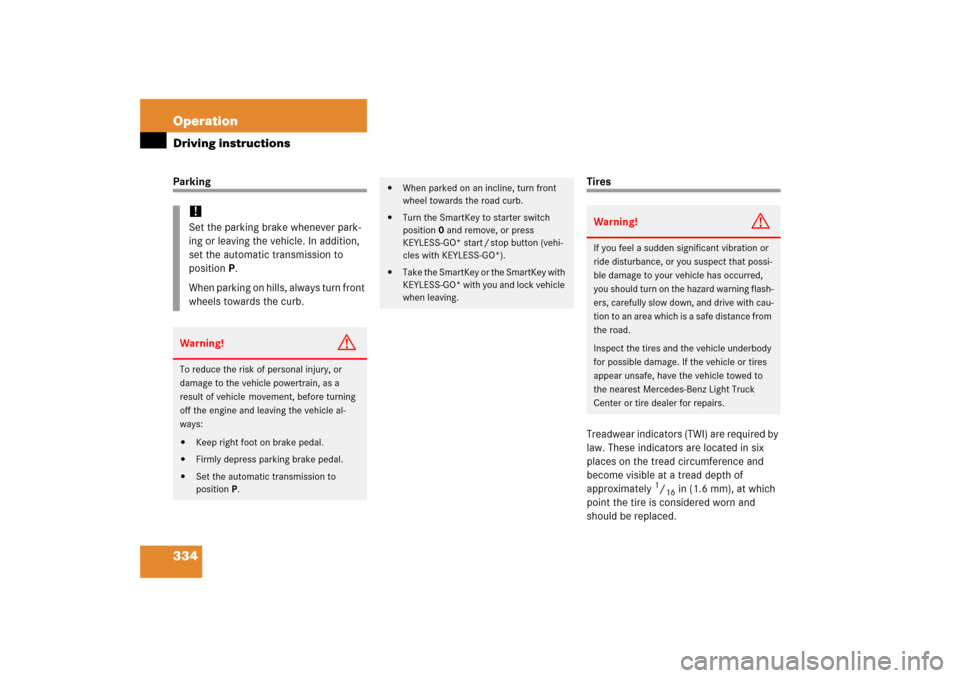
334 OperationDriving instructionsParking
Tires
Treadwear indicators (TWI) are required by
law. These indicators are located in six
places on the tread circumference and
become visible at a tread depth of
approximately
1/16
in (1.6 mm), at which
point the tire is considered worn and
should be replaced.
!Set the parking brake whenever park-
ing or leaving the vehicle. In addition,
set the automatic transmission to
positionP.
When parking on hills, always turn front
wheels towards the curb.Warning!
G
To reduce the risk of personal injury, or
damage to the vehicle powertrain, as a
result of vehicle movement, before turning
off the engine and leaving the vehicle al-
ways:�
Keep right foot on brake pedal.
�
Firmly depress parking brake pedal.
�
Set the automatic transmission to
positionP.
�
When parked on an incline, turn front
wheel towards the road curb.
�
Turn the SmartKey to starter switch
position0 and remove, or press
KEYLESS-GO* start / stop button (vehi-
cles with KEYLESS-GO*).
�
Take the SmartKey or the SmartKey with
KEYLESS-GO* with you and lock vehicle
when leaving.
Warning!
G
If you feel a sudden significant vibration or
ride disturbance, or you suspect that possi-
ble damage to your vehicle has occurred,
you should turn on the hazard warning flash-
ers, carefully slow down, and drive with cau-
tion to an area which is a safe distance from
the road.
Inspect the tires and the vehicle underbody
for possible damage. If the vehicle or tires
appear unsafe, have the vehicle towed to
the nearest Mercedes-Benz Light Truck
Center or tire dealer for repairs.
Page 406 of 561
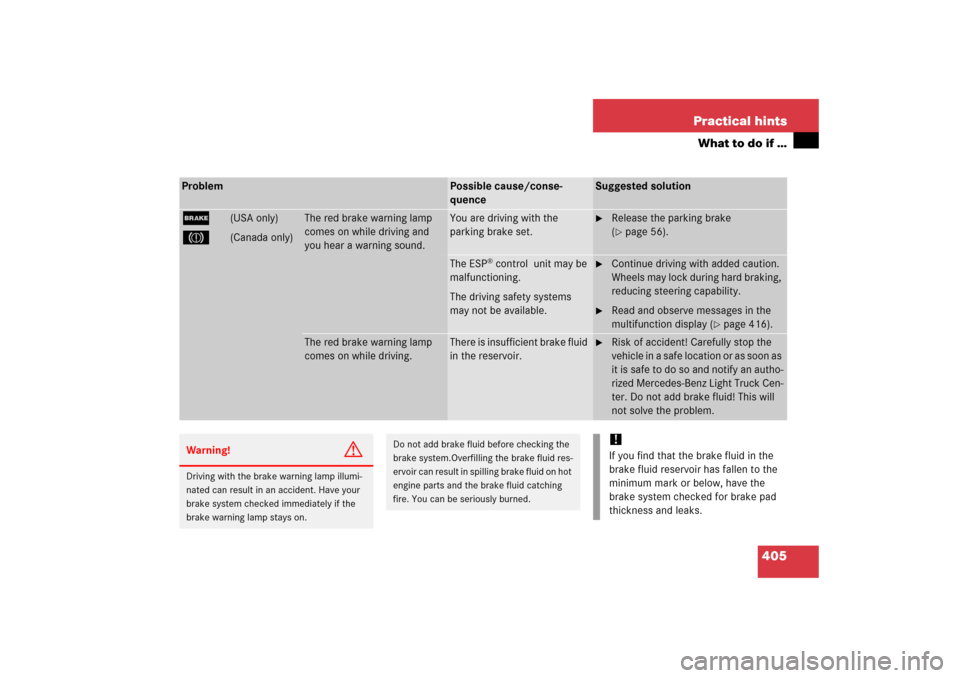
405 Practical hints
What to do if …
Problem
Possible cause/conse-
quence
Suggested solution
;
(USA only)
3
(Canada only)
The red brake warning lamp
comes on while driving and
you hear a warning sound.
You are driving with the
parking brake set.
�
Release the parking brake
(�page 56).
The ESP
® control unit may be
malfunctioning.
The driving safety systems
may not be available.
�
Continue driving with added caution.
Wheels may lock during hard braking,
reducing steering capability.
�
Read and observe messages in the
multifunction display (
�page 416).
The red brake warning lamp
comes on while driving.
There is insufficient brake fluid
in the reservoir.
�
Risk of accident! Carefully stop the
vehicle in a safe location or as soon as
it is safe to do so and notify an autho-
rized Mercedes-Benz Light Truck Cen-
ter. Do not add brake fluid! This will
not solve the problem.
Warning!
G
Driving with the brake warning lamp illumi-
nated can result in an accident. Have your
brake system checked immediately if the
brake warning lamp stays on.
Do not add brake fluid before checking the
brake system.Overfilling the brake fluid res-
ervoir can result in spilling brake fluid on hot
engine parts and the brake fluid catching
fire. You can be seriously burned.
!If you find that the brake fluid in the
brake fluid reservoir has fallen to the
minimum mark or below, have the
brake system checked for brake pad
thickness and leaks.
Page 408 of 561
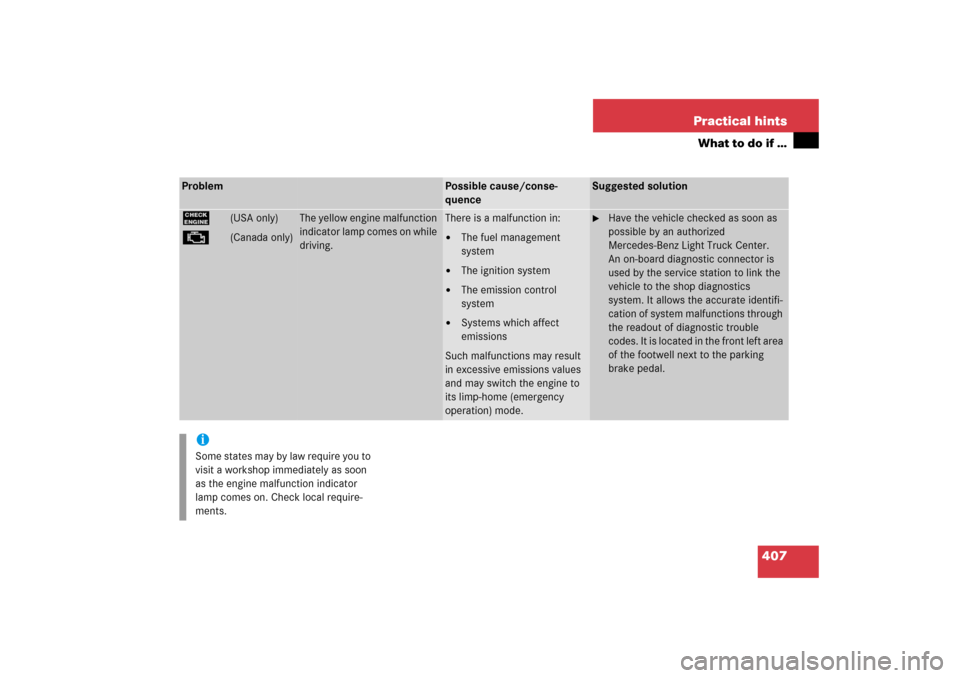
407 Practical hints
What to do if …
Problem
Possible cause/conse-
quence
Suggested solution
?
(USA only)
±
(Canada only)
The yellow engine malfunction
indicator lamp comes on while
driving.
There is a malfunction in:�
The fuel management
system
�
The ignition system
�
The emission control
system
�
Systems which affect
emissions
Such malfunctions may result
in excessive emissions values
and may switch the engine to
its limp-home (emergency
operation) mode.
�
Have the vehicle checked as soon as
possible by an authorized
Mercedes-Benz Light Truck Center.
An on-board diagnostic connector is
used by the service station to link the
vehicle to the shop diagnostics
system. It allows the accurate identifi-
cation of system malfunctions through
the readout of diagnostic trouble
codes. It is located in the front left area
of the footwell next to the parking
brake pedal.
iSome states may by law require you to
visit a workshop immediately as soon
as the engine malfunction indicator
lamp comes on. Check local require-
ments.
Page 432 of 561
431 Practical hints
What to do if …
Display symbol
Display message
Possible cause/consequence
Possible solution
;
(USA only)
!
(Canada only)
Release
parking brake
You are driving with the parking
brake set.
�
Release the parking brake (
�page 56).
;
(USA only)
3
(Canada only)
Changed braking behavior
Drive with extreme care
A malfunction in the Electronic
Brake Proportioning
(�page 102) was detected.
�
Continue driving with added caution.
Wheels may lock during hard braking,
reducing steering capability.
�
Read and observe messages in the multi-
function display.
�
Have the system checked at an autho-
rized Mercedes-Benz Light Truck Center
as soon as possible.
Failure to follow these instructions increases
the risk of an accident.
Page 446 of 561
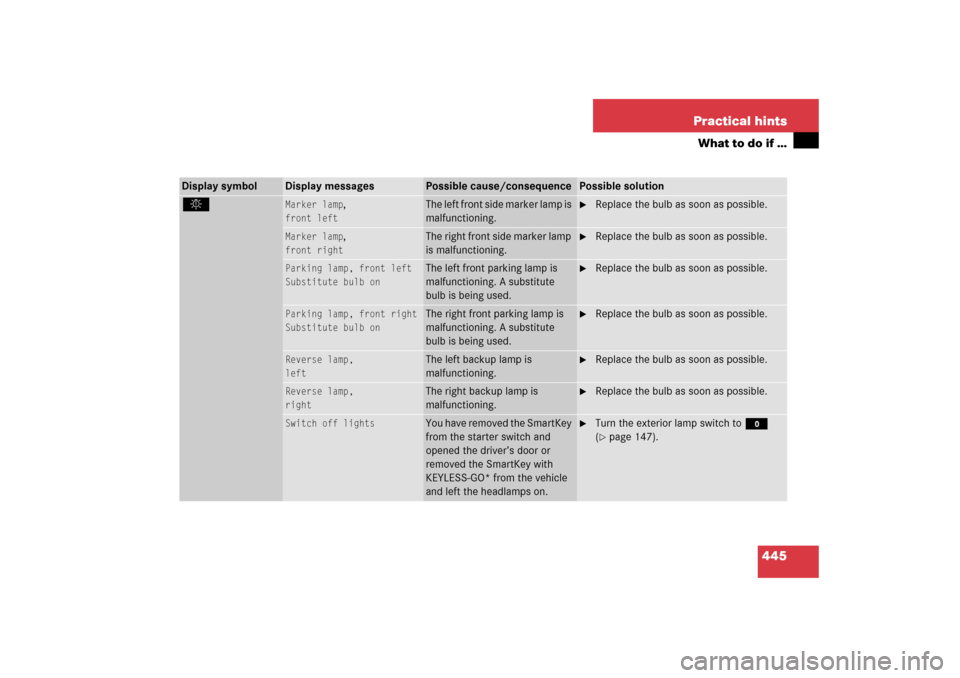
445 Practical hints
What to do if …
Display symbol
Display messages
Possible cause/consequence
Possible solution
.
Marker lamp
,
front left
The left front side marker lamp is
malfunctioning.
�
Replace the bulb as soon as possible.
Marker lamp
,
front right
The right front side marker lamp
is malfunctioning.
�
Replace the bulb as soon as possible.
Parking lamp, front left
Substitute bulb on
The left front parking lamp is
malfunctioning. A substitute
bulb is being used.
�
Replace the bulb as soon as possible.
Parking lamp, front right
Substitute bulb on
The right front parking lamp is
malfunctioning. A substitute
bulb is being used.
�
Replace the bulb as soon as possible.
Reverse lamp,
left
The left backup lamp is
malfunctioning.
�
Replace the bulb as soon as possible.
Reverse lamp,
right
The right backup lamp is
malfunctioning.
�
Replace the bulb as soon as possible.
Switch off lights
You have removed the SmartKey
from the starter switch and
opened the driver’s door or
removed the SmartKey with
KEYLESS-GO* from the vehicle
and left the headlamps on.
�
Turn the exterior lamp switch toM
(�page 147).
Page 457 of 561
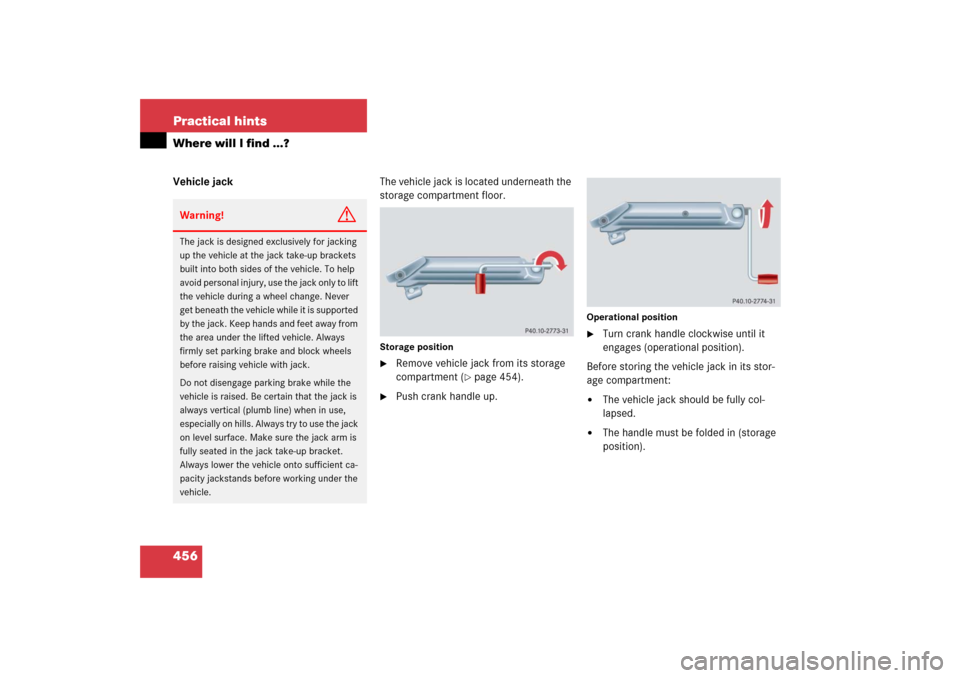
456 Practical hintsWhere will I find ...?Vehicle jackThe vehicle jack is located underneath the
storage compartment floor.
Storage position�
Remove vehicle jack from its storage
compartment (
�page 454).
�
Push crank handle up.
Operational position�
Turn crank handle clockwise until it
engages (operational position).
Before storing the vehicle jack in its stor-
age compartment:
�
The vehicle jack should be fully col-
lapsed.
�
The handle must be folded in (storage
position).
Warning!
G
The jack is designed exclusively for jacking
up the vehicle at the jack take-up brackets
built into both sides of the vehicle. To help
avoid personal injury, use the jack only to lift
the vehicle during a wheel change. Never
get beneath the vehicle while it is supported
by the jack. Keep hands and feet away from
the area under the lifted vehicle. Always
firmly set parking brake and block wheels
before raising vehicle with jack.
Do not disengage parking brake while the
vehicle is raised. Be certain that the jack is
always vertical (plumb line) when in use,
especially on hills. Always try to use the jack
on level surface. Make sure the jack arm is
fully seated in the jack take-up bracket.
Always lower the vehicle onto sufficient ca-
pacity jackstands before working under the
vehicle.